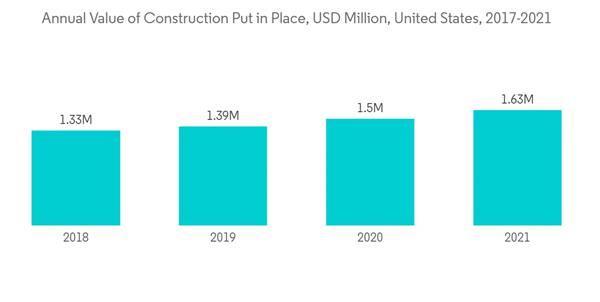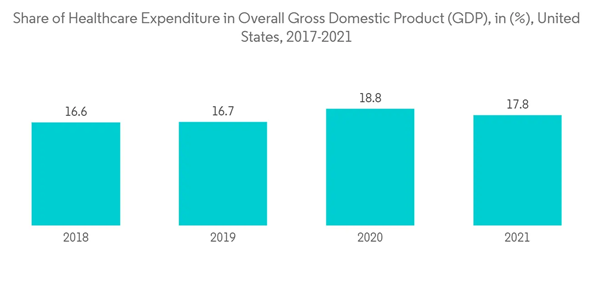Key Highlights
- Over the short term, increasing applications in healthcare and rising demand for spunbound are likely to increase demand for the non-woven fabric market during the forecast period.
- But the fabric's low durability and strength are likely to slow down the growth of the studied market.
Nevertheless, product and research development activities and the proliferation of new technologies like root control bags are expected to propel the expansion of aid merchandise in the United States and are likely to act as an opportunity in the future for the studied market over the forecast period.
US Non-Woven Fabric Market Trends
The Healthcare Industry Promotes the Demand for Non-Woven Fabric
- The use of nonwoven materials in medical applications is growing as a result of the emergence of low-cost products for use in cost-conscious institutions. Products like surgical robes, drapes, gloves, and wraps for instruments, which can be used once and thrown away, are used a lot in hospitals.
- The United States government's initiatives to control hospital non-heritable infections are expected to promote the use of nonwoven medical merchandise, such as disposable patient robes, drapes, and linens, which help reduce the provision of raw materials.
- Nonwoven textiles contain more than 80% synthetic fibers per square meter.Many of these fibers, such as polyester and cotton, are abundant and inexpensive.
- The nonwoven fabric price per ton in August 2022 was USD 5.8K, remaining stable from the previous month. In general, import prices increased significantly. The highest rate of growth was observed in July 2022, with an increase of 852% over the previous month. In August 2022, the import price peaked.The average price varied greatly across the major supplying countries.
- According to the United States Census Bureau, the annual value of construction put in place was about USD 1.63 million in 2021, compared to USD 1.49 million in 2020.
- All of the aforementioned factors are expected to drive the healthcare segment, which will boost demand for non-wovens in the US during the forecast period.
Construction Industry also Holds a Significant Share of the Non-Woven Fabric Market
- Durable non-woven fabric materials are employed in the construction industry since the fabric must survive adverse environmental conditions. Non-woven fabric is used in various construction applications, including, roofing, carpets, carpet foundation materials, dew absorbent sheets, wall materials, soundproofing materials, vibration absorbers, plywood materials, and curing sheets.
- Materials used in civil engineering include drain materials, soil draw-out prevention materials, separating materials, water-shielding sheets, reinforcing materials, erosion prevention materials, concrete molding sheets, asphalt overlay materials, underground pipe repair materials, and anti-corrosive materials.
- In the construction industry, the main purpose of non-woven fabric is to reduce heat, water, sunlight, extreme weather, flame retardancy, surface protection, and air conditioning loss.
- These materials are also used in the underlayment of roofs and tiles, as house wraps, for drainage, and in other ways to keep heat and noise out.
- Non-woven fabrics are expected to see increased demand due to their cost-effectiveness and efficiency during the projected period. The United States has one of the most important construction industries in the world. By the end of 2022, it is expected to bring in more than USD 135 billion.
- The US Census Bureau estimated the value of the commercial construction sector in 2021 to be USD 91.03 billion. Furthermore, public construction spending on commercial projects in the United States is expected to reach USD 3.54 billion in 2021. Private, and governmental construction spending in the United States reached USD 1,591.70 billion in 2021.
- According to the Organization for Economic Cooperation and Development (OECD), the share of healthcare expenditure in overall GDP was 17.8 percent in 2021, compared to 18.8 percent in 2020.
Growing construction activity and the need for long-lasting nonwoven fabric materials used in the construction industry are likely to fuel the nonwoven fabric market's expansion in the United States.
US Non-Woven Fabric Market Competitor Analysis
The United States Non-Woven Fabric market is partially fragmented in nature. The major manufacturers in the market (in no particular order) include 3M, Lydall Inc., Toray Industries Inc, DuPont, and Glatfelter Corporation followed by other prominent players.Additional benefits of purchasing the report:
- The market estimate (ME) sheet in Excel format
- 3 months of analyst support
This product will be delivered within 2 business days.
Table of Contents
1 INTRODUCTION1.1 Study Assumptions
1.2 Scope of the Study
2 RESEARCH METHODOLOGY
3 EXECUTIVE SUMMARY
4 MARKET DYNAMICS
4.1 Drivers
4.1.1 Increasing Applications in the Healthcare Industry
4.1.2 Increasing Demand for Spunbond
4.2 Restraints
4.2.1 Low Durability and Strength of the Fabric
4.2.2 Other Restraints
4.3 Industry Value-Chain Analysis
4.4 Porter's Five Forces Analysis
4.4.1 Bargaining Power of Suppliers
4.4.2 Bargaining Power of Buyers
4.4.3 Threat of New Entrants
4.4.4 Threat of Substitute Products and Services
4.4.5 Degree of Competition
5 MARKET SEGMENTATION
5.1 By Technology
5.1.1 Spunbond
5.1.2 Wet-laid
5.1.3 Dry-laid
5.1.4 Other Technologies
5.2 By Material
5.2.1 Polyester
5.2.1.1 Polyester Staple Fiber
5.2.1.2 Polyester Resin (Bottle Grade)
5.2.2 Polypropylene
5.2.2.1 Polypropylene Resin
5.2.2.2 Polypropylene Staple Fiber
5.2.3 Polyethylene
5.2.4 Rayon
5.2.5 Fluff Pulp
5.2.6 Other Materials
5.3 By End-User Industry
5.3.1 Construction
5.3.2 Textiles
5.3.3 Healthcare
5.3.4 Automotive
5.3.5 Other End-User Industries
6 COMPETITIVE LANDSCAPE
6.1 Mergers and Acquisitions, Joint Ventures, Collaborations, and Agreements
6.2 Market Ranking Analysis**
6.3 Strategies Adopted by Leading Players
6.4 Company Profiles
6.4.1 3M
6.4.2 Ahlstrom-Munksjo
6.4.3 Berry Global Inc.
6.4.4 DuPont
6.4.5 Freudenberg Performance Materials
6.4.6 Fybon Nonwovens Inc.
6.4.7 Glatfelter Corporation
6.4.8 Jasztex Inc.
6.4.9 Johns Manville
6.4.10 KCWW
6.4.11 Lydall Inc.
6.4.12 PFNonwovens Holding SRO
6.4.13 Suominen Corporation
7 MARKET OPPORTUNITIES AND FUTURE TRENDS
7.1 Product and Research Developmental Activities
7.2 Proliferation of New Technologies like Root Control Bags
Companies Mentioned (Partial List)
A selection of companies mentioned in this report includes, but is not limited to:
- 3M
- Ahlstrom-Munksjo
- Berry Global Inc.
- DuPont
- Freudenberg Performance Materials
- Fybon Nonwovens Inc.
- Glatfelter Corporation
- Jasztex Inc.
- Johns Manville
- KCWW
- Lydall Inc.
- PFNonwovens Holding SRO
- Suominen Corporation










